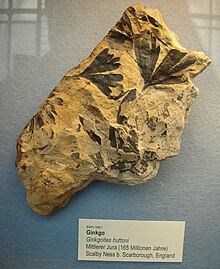
Ginkgoales are a gymnosperm order containing only one extant species: Ginkgo biloba, the ginkgo tree. It is monotypic, within the class Ginkgoopsida, which itself is monotypic within the division Ginkgophyta. The order includes five families, of which only Ginkgoaceae remains extant.
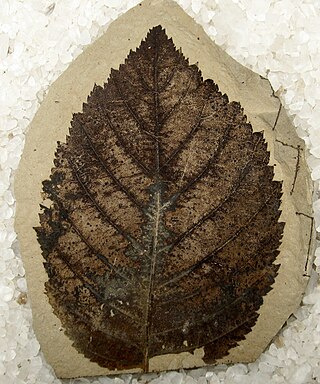
Paleobotany, also spelled as palaeobotany, is the branch of botany dealing with the recovery and identification of plant remains from geological contexts, and their use for the biological reconstruction of past environments (paleogeography), and the evolutionary history of plants, with a bearing upon the evolution of life in general. A synonym is paleophytology. It is a component of paleontology and paleobiology. The prefix palaeo- or paleo- means "ancient, old", and is derived from the Greek adjective παλαιός, palaios. Paleobotany includes the study of terrestrial plant fossils, as well as the study of prehistoric marine photoautotrophs, such as photosynthetic algae, seaweeds or kelp. A closely related field is palynology, which is the study of fossilized and extant spores and pollen.

Birbal Sahni FRS was an Indian paleobotanist who studied the fossils of the Indian subcontinent. He also took an interest in geology and archaeology. He founded what is now the Birbal Sahni Institute of Palaeobotany at Lucknow in 1946. His major contributions were in the study of the fossil plants of India and in plant evolution. He was also involved in the establishment of Indian science education and served as the President of the National Academy of Sciences, India and as an Honorary President of the International Botanical Congress, Stockholm.

Sir Albert Charles Seward FRS was a British botanist and geologist.

Prototaxites is a genus of terrestrial fossil fungi dating from the Middle Ordovician until the Late Devonian periods, approximately 470 to 360 million years ago. Prototaxites formed small to large trunk-like structures up to 1 metre (3 ft) wide, reaching 8 metres (26 ft) in length, made up of interwoven tubes around 50 micrometres (0.0020 in) in diameter, making it by far the largest land-dwelling organism of its time.

Polysporangiophytes, also called polysporangiates or formally Polysporangiophyta, are plants in which the spore-bearing generation (sporophyte) has branching stems (axes) that bear sporangia. The name literally means 'many sporangia plant'. The clade includes all land plants (embryophytes) except for the bryophytes whose sporophytes are normally unbranched, even if a few exceptional cases occur. While the definition is independent of the presence of vascular tissue, all living polysporangiophytes also have vascular tissue, i.e., are vascular plants or tracheophytes. Extinct polysporangiophytes are known that have no vascular tissue and so are not tracheophytes.
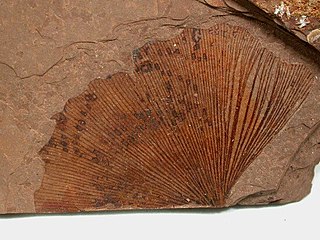
Ginkgo is a genus of non-flowering seed plants. The scientific name is also used as the English name. The order to which it belongs, Ginkgoales, first appeared in the Permian, 270 million years ago, and Ginkgo is now the only living genus within the order. The rate of evolution within the genus has been slow, and almost all its species had become extinct by the end of the Pliocene. The sole surviving species, Ginkgo biloba is only found in the wild in China, but is cultivated around the world. The relationships between ginkgos and other groups of plants are not fully resolved.
Koonwarra is a town in the South Gippsland region of Victoria, Australia. At the 2016 census, Koonwarra had a population of 404. The town straddles the South Gippsland Highway. Located around 128 km southeast of Melbourne, the town was served by rail from the 1890s until 1991 with the closing of the rail line to Barry Beach.
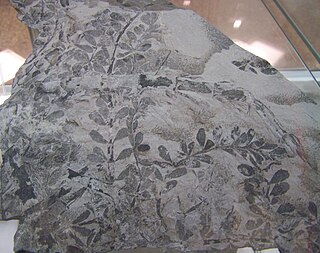
Sphenophyllales is an extinct order of articulate land plants and a sister group to the present-day Equisetales (horsetails). They are fossils dating from the Devonian to the Triassic. They were common during the Late Pennsylvanian to Early Permian, with most of the fossils coming from the Carboniferous period.

Taeniocrada is a genus of extinct plants of Devonian age. It is used as a form genus for fossil plants with leafless flattened stems which divided dichotomously and had prominent midribs regarded as containing vascular tissues. It has been suggested that some species assigned to this genus were aquatic.
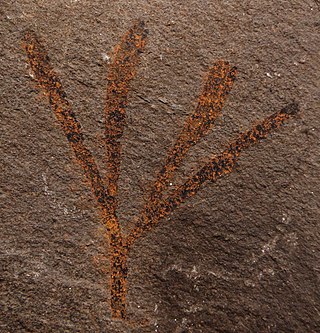
Sphenobaiera is a form genus for plant leaves found in rocks from Triassic to Cretaceous periods. The genus Sphenobaiera is used for plants with wedge-shaped leaves that can be distinguished from Ginkgo, Ginkgoites and Baiera by the lack of a petiole. It became extinct about 72.6 million years ago. The family to which this genus belongs has not been conclusively established; an affinity with the Karkeniaceae has been suggested on morphological grounds.

Cycadeoidea is an extinct genus of bennettitalean plants known from the Cretaceous of North America, Europe and Asia. They grew as cycad-like plants with a short trunk topped with a crown of leaves.

Ginkgo huttonii is an extinct Ginkgo species in the family Ginkgoaceae from the Jurassic of England. The fossil is also known by the name, Ginkgoites huttonii, the genus, Ginkgoites, referring to a group of extinct members of the Ginkgoaceae. G. huttonii was a broad-leaved, deciduous gymnosperm bearing resemblance to the only living member of the Ginkgoaceae, Ginkgo biloba.
Cyclodendron was a genus of lycophytes dating from the Permian. Plants were vascularized with reproduction by spores.
Glyptolepis is an extinct morphogenus of female conifer cones from the Triassic. It was established in 1872 by the French botanist Wilhelm Philippe Schimper. The morphogenus is characterized by having bract scale complexes with elongated seed scale stalks. The seed scales each contain two recurved ovules and are distinctively flattened with five or six lobes. The name is derived from Ancient Greek γλυπτό and λεπίς.

Dipteris is a genus of about seven species of ferns, native to tropical regions across the world, particularly Asia, with a species in northeastern Queensland in Australia. It is one of two genera in the family Dipteridaceae.

Baiera is a genus of prehistoric gymnosperms in the order Ginkgoales. It is one of the oldest fossil foliage types of Ginkgoales, and is related to the genera Ginkgo and Ginkgoites. Fossils of Baiera are found worldwide, and have been known from the Permian to the Cretaceous.

Ctenis is a genus of fossil foliage attributable to the Cycadales, being one of the most common genera of cycad fossil leaves in the Mesozoic.
Pseudoctenis is a genus of fossil foliage attributable to the Cycadales. It is one of the most common genera of cycad fossil foliage in the Mesozoic.
Helen Holme Simmons FRS FLS, commonly known as Nellie Bancroft, was a British botanist and scientific illustrator famous for her work on plant systematics and the anatomy of both living and fossil plants. Bancroft was while working for the Imperial Forestry Institute in France in 1940 captured by the Germans and spent four years in internment before being released and returning home in 1944.
